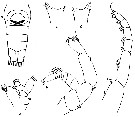|
|
 |
Fiche d'espèce de Copépode |
|
|
Calanoida ( Ordre ) |
|
|
|
Arietelloidea ( Superfamille ) |
|
|
|
Heterorhabdidae ( Famille ) |
|
|
|
Neorhabdus ( Genre ) |
|
|
| |
Neorhabdus falciformis (Wolfenden, 1911) (F,M) | |
| | | | | | | Syn.: | Hemirhabdus falciformis Wolfenden, 1911 (p.310, Descr.F, figs.F, Rem.M) | | | | Ref.: | | | Heptner, 1972 a (p.59); Bradford-Grieve & al., 1999 (p.883, 943, figs.F,M); Park, 2000 (p.63, Redescr.F,M, figs.F,M, Rem |  issued from : T. Park in Bull. Scripps Inst. Oceanogr. Univ. California, San Diego, 2000, 31. [p.189, Fig.37]. Female: a, habitus (left); b, urosome (left); c, urosome with 2nd somite deeply telescoped (left); d, urosome (dorsal); e, genital somite (ventral); f, left Mx1 (posterior); g, left Mx2 (posterior); h, right Mxp (anterior). Nota: Prosome about 3/4 length of body and about3.1 times as long as urosome. Cephalosome about 2/5 length of prosome. Urosome about 1/4 length of body.. Dorsally, genital somite about as long as wide, with only slightly curved lateral margins; laterally, genital somite with a high genital prominence, deeper than long, typically with a deepth-length ratio of 100:85. Ventrally, genital operculum typically with a width-length ratio of 100:67 and 1/2 as wide as somite itself (as in N. latus). A1 reaching about posterior end of caudal ramus, its setation as in N. latus, segments 6-12 each with 2 setae, but the number of aesthetes on these segments are 2, 1, 3, 1, 0, 0, 0, (instead of 4, 2, 3, 2, 1, 1, 1, as found in N. latus) Male: i, basipods of P5 (anterior); j, basis and exopod of right P5 (anterior); k, basis and exopod of left P5 (anterior). Nota: Prosome about 3/4 length of body and about 3.0 times length of urosome. Left genicular A1 with many aesthetes on segments 1-9, similar in setation to that of N. latus male. Other cephalosomal appendages and P1 to P4 as in female. P5 similar to that of N. latus male but differs from it: 1- Inner lobe of right basis relatively short (Fig.37-i), with convex outer margin, 2 - 3rd segment of right exopod (Fig.37-j) with only 1 outer spine and 2 elevated pores (intead of 2 outer spines and 3 elevated pores in N. latus), 3 - 3rd segment of left exopod (Fig.37-k) has 2 elevated pores, instead of 3 in N. latus, and its inner and terminal spines better developed.
|
 issued from : R.N. Wolfenden in Die Marinen Copepoden der Deutschen Südpolar-Expedition 1901-1903, 1911. [p.311, Fig.57]. As Hemirhabdus falciformis. Female: a, urosome (ventral); b, A2; c-d, Md (masticatory edge); e, Mx1; f, Mxp.
|
 Neorhabdus falciformis Neorhabdus falciformis female and male: 1 - In 3rd lobe of Mx2, anterior spine much smaller than 1st terminal spine (Fig.37-g); Mx1 with 2nd inner lobe missing (Fig.35-a). 2 - 2nd distal seta of Mxp coxa approximately 1.5 times length of 1st (Fig.37-f); in 3rd lobe of Mx2, 1st terminal spine approximately 1.5 times length of anterior spine (Fig.37-g).
| | | | | NZ: | 3 | | |
|
Carte de distribution de Neorhabdus falciformis par zones géographiques
|
| | | | | | | Loc: | | | S tropical Atlant. (off I. da Trindade E), SW Indian, Pacif. (tropical central: N-S, E-W).
Type locality: South Atlantic (about 23°S, 21°W). | | | | N: | 2 | | | | Lg.: | | | (10) F: 5,6; (824) F: 6,83-6,16; M: 6,08; {F: 5,60-6,83; M: 6,08} | | | | Rem.: | bathypélagique.
Pour Wolfenden la P5 du mâle est très proche de celle de Hemirhabdus grimaldii mais s'en distingue: par la forme plus ramassée, les B2 à bords plus fortement poilus, les exopodites un peu plus longues et l'appendice sur l'article 2 de l'exopodite de la patte droite un peu moins ovoïde
Voir aussi les remarques en anglais | | | Dernière mise à jour : 24/01/2015 | |
|
|
 Toute utilisation de ce site pour une publication sera mentionnée avec la référence suivante : Toute utilisation de ce site pour une publication sera mentionnée avec la référence suivante :
Razouls C., Desreumaux N., Kouwenberg J. et de Bovée F., 2005-2025. - Biodiversité des Copépodes planctoniques marins (morphologie, répartition géographique et données biologiques). Sorbonne Université, CNRS. Disponible sur http://copepodes.obs-banyuls.fr [Accédé le 04 janvier 2026] © copyright 2005-2025 Sorbonne Université, CNRS
|
|
 |
 |





